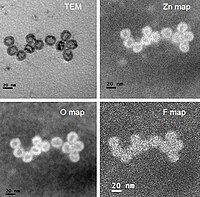
Photo from wikipedia
InAs-based nanocrystals can enable RoHS-compliant optoelectronic devices, but their photoluminescence efficiency needs improvement for practical applications. We report an optimized synthesis of InAs@ZnSe core@shell nanocrystals that allows to finely tune… Click to show full abstract
InAs-based nanocrystals can enable RoHS-compliant optoelectronic devices, but their photoluminescence efficiency needs improvement for practical applications. We report an optimized synthesis of InAs@ZnSe core@shell nanocrystals that allows to finely tune the ZnSe shell thickness up to 7 mono-layers (MLs) and to boost the emission, reaching a quantum yield of ∼70% at ∼900 nm. We demonstrate that a high quantum yield can be attained when the shell thickness is at least ∼3ML. Notably, the photoluminescence lifetime (58 ns) does not vary much as a function of the shell thickness, whereas the Auger recombination time (a limiting aspect in technological applications when fast) slows down from 11 ps to 38 ps when increasing the shell thickness from 1.5 to 7MLs. Chemical and structural analyses evidence that InAs@ZnSe nanocrystals do not exhibit any strain at the core-shell interface, likely due to the formation of an In-Zn-Se interlayer. Such interpretation is supported by atomistic modelling, which indicates the interlayer as being composed of In, Zn, Se and cation vacancies, alike to the In2 ZnSe4 crystal structure. The simulations reveal an electronic structure consistent with that of type-I heterostructures, in which localized trap states can be passivated by a thick shell (>3ML) and excitons are confined in the core. This article is protected by copyright. All rights reserved.
Journal Title: Advanced materials
Year Published: 2023
Link to full text (if available)
Share on Social Media: Sign Up to like & get
recommendations!